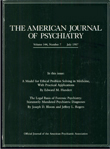PANDAS Variant and Body Dysmorphic Disorder
To the Editor: A subgroup of patients with obsessive-compulsive disorder (OCD) and pediatric autoimmune neuropsychiatric disorders associated with streptococcal infections (PANDAS) display symptom exacerbations that are temporally linked to streptococcal infections (1). We report on a patient with severe body dysmorphic disorder and major depression who experienced an exacerbation of symptoms after a streptococcal infection.
Mr. A was a 19-year-old Hispanic man who was admitted to our inpatient unit with the diagnoses of recurrent major depression and body dysmorphic disorder. He reported that he spent up to 8 hours a day checking his face in the mirror and picking at perceived facial blemishes and acne scars. (An examination revealed one or two small, barely visible acne blemishes on his nose.) Mr. A’s past history was notable for rheumatic fever at age 8 that had been treated with monthly intramuscular penicillin injections until he was age 12. He and his family reported no childhood symptoms of OCD or tic disorders. He and his family first reported that symptoms of body dysmorphic disorder had appeared at age 14, and by age 16 his symptom profile had been so severe that he had dropped out of school for fear of being scrutinized and talked about by his classmates.
At age 18 he had been admitted to the unit with similar psychiatric symptoms, as well as complaints of a sore throat. The result of a group A streptococcal throat culture had been positive, and he had been given a 10-day course of penicillin. It had been noted that his symptoms of body dysmorphic disorder had improved after penicillin treatment, although he had had little response to low doses of haloperidol up to that point. After the treatment with penicillin, Mr. A had been switched from haloperidol to paroxetine therapy, which had been increased by stages up to 40 mg/day. He had continued to improve after discharge; however, he had been lost to follow-up.
When Mr. A returned 1 year later, his Hamilton Depression Rating Scale score was 33, and his Yale-Brown Obsessive Compulsive Scale score was 26. He again began treatment with paroxetine, which was rapidly increased to 60 mg/day over 3 weeks. By the end of his 4 weeks of hospitalization, his Hamilton depression scale score was 8, and his Yale-Brown Obsessive Compulsive Scale score was 6. He was much improved in mood, and his symptoms of body dysmorphic disorder were better. Before admission, he had had no complaints of a sore throat, and in the hospital, the result of a group A streptococcal throat culture had been negative. As part of a workup for PANDAS, additional serologies were obtained, the results of which revealed an elevated anti-streptolysin O titer of 739 IU/ml (normal: <200 IU/ml) and an elevated DNAase B antibody level of 340 IU/ml(normal: <170 IU/ml). Follow-up antibody titers could not be obtained.
Our patient met some of the criteria for PANDAS. His first admission might have been triggered by his streptococcal infection, which appeared to correlate with worsening symptoms of body dysmorphic disorder. At the second hospitalization, there was serological evidence for remote, but not acute, infection.
1. Swedo SE, Leonard HL, Garvey M, Mittleman B, Allen AJ, Perlmutter S, Lougee L, Dow S, Zamkoff J, Dubbert BK: Pediatric autoimmune neuropsychiatric disorders associated with streptococcal infections: clinical description of the first 50 cases. Am J Psychiatry 1998; 155:264–271; erratum, 155:578Abstract, Google Scholar



